Downloads
Introduction
Australia’s resources investment boom is a topic familiar to us all. I’m going to talk about it again today.
It’s a familiar topic for good reason: it has seen one of the largest changes in the structure of our economy in modern times, certainly outside of wartime.
Further, we are at an interesting point in the boom’s evolution. We passed the peak in the terms of trade three years ago, in the September quarter 2011, and we’ve recently passed the peak in capital investment into the resources sector. So we’re now in the third and final phase of the boom, the phase characterised by strongly rising production and export volumes, but falling prices and investment.
How will this final phase pan out? Will we see a relatively seamless transition, as economic activity and employment opportunities in the non-resource parts of the economy take up the slack left by declining resources investment? Or, alternatively, in Ross Garnaut’s (2013) words: are the salad days behind us, and the dog days upon us?
The commodity price boom delivered a huge windfall income gain to Australia. Professor Garnaut argues that it was squandered, contributing to a loss of economic reform momentum during what he describes as ‘the Great Complacency’. With commodity prices now falling as supply capacity comes online, Professor Garnaut’s thesis is that the Australian economy faces a hard landing in the absence of bold productivity-enhancing reform.2
There are good reasons to take these warnings seriously, not least because Australia’s previous terms-of trade/resources booms definitely did end in dog days. And this boom is considerably larger than its predecessors.
But looking at the performance of the economy, I think the appropriate conclusion is “so far, so good”. There has been an economic adjustment – including in the labour market, with a significant fall in the participation rate and the unemployment rate touching 6 per cent earlier in the year.
I don’t want to downplay the hardship associated with unemployment. But, to my mind, if the unemployment rate peaks at around 6 per cent or a little above – as Treasury and many other forecasters think it will – then that will be little short of an astounding achievement given the size of both the boom and the subsequent adjustment now underway.
It remains early days, certainly in terms of the investment downswing, but the signs at this stage are promising. If we are experiencing dog days, then at least the dog appears better trained than in the past.
Let me take you through some of the arguments why I think the transition will not be too disruptive.
The salad days
First, let me remind you how big this boom has been. I still find the following two charts amazing, even though I’ve seen them many times.
Chart 1 – Terms of trade
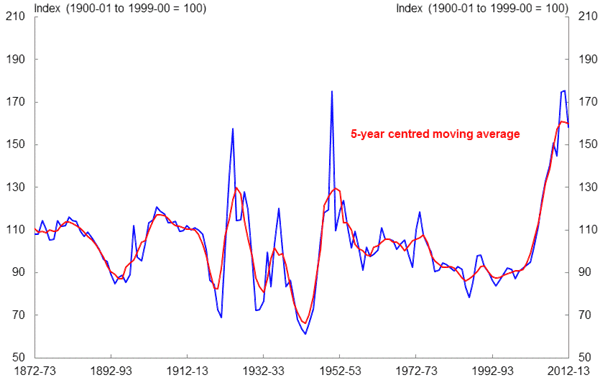
Note: Budget forecasts and projections are used to construct the 5-year centred moving average for the latest few years.
Rapid industrialisation in China and other emerging economies had, by mid last decade, generated a massive increase in the demand for steel and inputs to steel production. Australia has large, good quality, reserves of metallurgical coal and iron ore and is an established and reliable producer of both.3
With little spare global capacity, and long lead times on new investment, supply couldn’t keep pace with demand, and prices shot up.
At the same time, Australian consumers and businesses benefited from access to cheaper manufactured goods from Asia. So, rapid development in Asia boosted real incomes in Australia through both higher export prices and lower import prices.
The combined impact generated the largest sustained rise in Australia’s terms of trade ever seen – an outcome that makes the terms-of-trade boom of the 1970s look like a pretty mild affair.4
Chart 2 – Resources investment
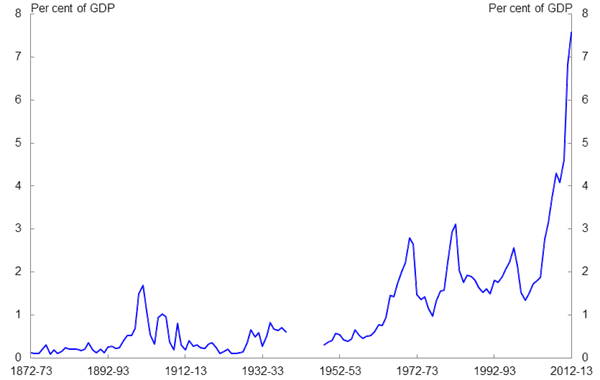
Note: Data before 1959-60 are on a calendar year basis.
The result was that resources investment increased from less than 2 per cent of GDP pre-boom to around 7½ per cent in 2012-13, an increase, in dollar terms, from around $14 billion to more than $100 billion a year.5 This has seen an additional 180,000 workers employed in the resources sector since the boom began and will see the capital stock in the resources sector almost quadruple by 2015-16.
Real economic adjustment – so far, so good
Clearly the data from the resources sector over the past decade have been remarkable, but how has the broader economy fared in adjusting to this shock? The short answer is ‘pretty well’. The 70s boom provides a good basis for comparison.
Chart 3 – Current terms of trade boom
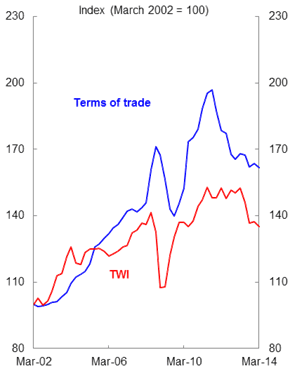
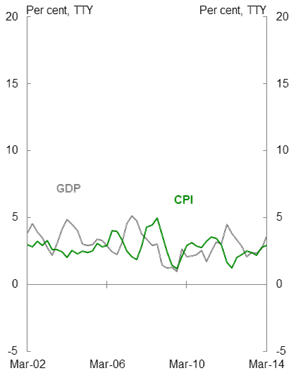
For the past decade, real GDP growth has been relatively stable and not too far from trend, the unemployment rate has stayed within a percentage point either side of 5 per cent, and the dispersion of unemployment across the country has remained relatively low (Gruen, 2011). Inflation has been mostly within the Reserve Bank’s medium-term target band.6
Chart 4 – 1970s terms of trade boom
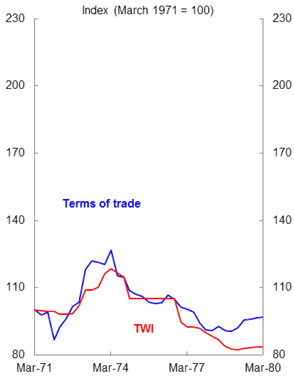
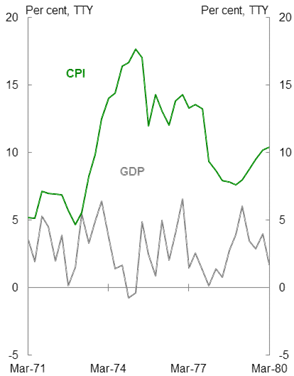
This experience stands in contrast to the 1970s boom, when both real GDP growth and inflation showed considerable volatility (Chart 4). The shock led to a ratcheting up of the unemployment rate, from less than 2 per cent at the beginning of the 1970s to more than 6 per cent at its end.
Australia’s improved macroeconomic policy frameworks deserve much of the credit for this better performance. The floating exchange rate, independent monetary policy and more decentralised wage bargaining have all been important. Relative prices adjust more quickly now than they could in earlier decades, and the result has been less disruption to the economy and, importantly, to the labour market.
Chart 5 – Industry wages relative to aggregate wages
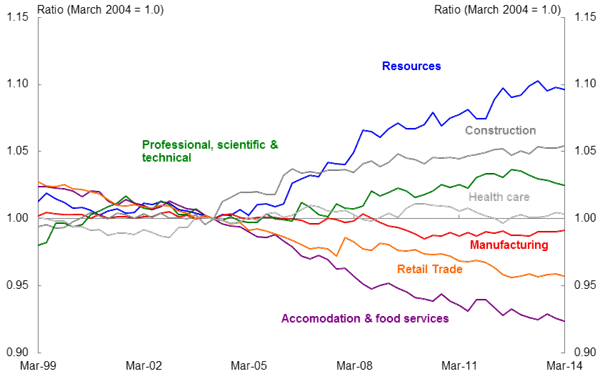
Note: Industry WPIs (Wage Price Indexes) relative to the aggregate WPI, indexed to 1 in March 2004.
As the resources boom gathered strength from around 2004, relative wages in the resources, construction and professional services sectors responded to the strong demand for labour in those sectors (Chart 5). As the boom subsides, there may be significant retracement of these wage gaps, with recent outcomes suggesting this is beginning to occur. This sort of relative wage adjustment didn’t occur in the 1970s or 80s.
But how did we spend the boom?
This adjustment in the real economy is important. An adjustment that produces less unemployment is to be celebrated. But there is also the issue of the incomes from the higher terms of trade and how they were spent.
Ross Garnaut and ot
hers have suggested that this income was misspent during the good times, with the corollary being that when income growth subsides with the falling terms of trade, the transition will be more difficult.
I don’t think this proposition is supported by the available evidence.
This observation in no way undermines the need for budget repair. Before the decisions taken in the Budget, Australia had a structural budget deficit that economic growth alone would not fix any time soon (Parkinson, 2014). Significant and steady improvement is needed in the structural position of the budget, both to recharge the fiscal buffers to be ready for future unanticipated shocks, and to make room for longer-term fiscal pressures – from ageing, healthcare and other social programs.
But it is also important to remember that the terms of trade boom provided a boost to the real incomes of all sectors, including households, businesses and government. Taking the country as a whole, there is little evidence that the windfall gains from the boom were consumed.
The boom in Australia saw rapid growth in nominal GDP (and in nominal incomes). The boom was also characterised, however, by national consumption taking a declining share of nominal GDP – and indeed taking a significantly smaller share than in other Anglophone countries (Chart 6).
Chart 6 – National Consumption
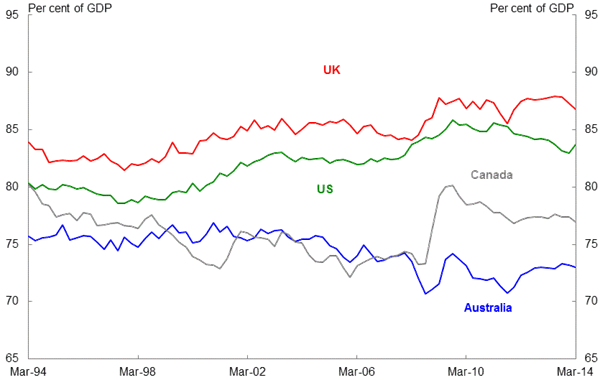
Note: National consumption is final consumption expenditure by households and government.
For Australia, the corollary of a declining share of consumption in national output was a gradually rising share of gross national saving (not shown).
Australia stands out among Anglophone countries not only in having a low and declining share of national consumption (Chart 6), but also in having a high and rising share of national investment – at least until the latest few quarters (Chart 7).
Rather than the income gains from the boom having been consumed, it would be more accurate to conclude that they were invested.7
Chart 7 – National Investment
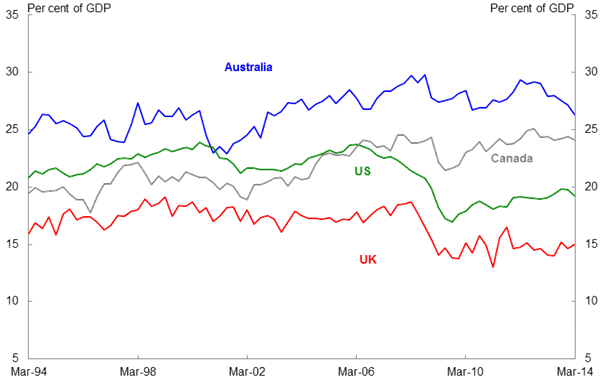
Note: National investment is the sum of private and public gross fixed capital formation and changes in inventories.
Dog days – bark or bite?
Where to from here? Undoubtedly, economic outcomes will be shaped by a number of opposing forces.
Over the next three or four years, resources investment is expected to fall from around 7 per cent of GDP currently to something closer to 2-3 per cent.8 Commodity prices are likely to continue to fall – as a result of both a continuing increase in supply, and slower and less resource-intensive growth in the Chinese economy as it transitions to a new growth model less dependent on investment and exports.
On the other side of the coin, Australian export volumes should continue to grow strongly. Australia is becoming a much larger producer of iron ore, gaining market share in China, and will likely move from being a small exporter of LNG to challenge the world’s largest, Qatar.
In the context of the expected sharp decline in resources investment, the Government announced an infrastructure package in the 2014-15 Budget, estimated to raise infrastructure spending by $58 billion (or nearly 4 per cent of current annual GDP) over the next several years – which should enable some of the people freed up from the downswing of the resources investment boom to gain productive employment.
The non-resources economy, subdued by below-average household spending and a business sector waiting for a sustained pick-up in demand, is expected to recover gradually. There are already signs of a strong pick-up in dwelling investment, and a gradual recovery in household consumption, both supported by an extended period of expansionary monetary policy and stronger household balance sheets.
A delayed pick-up in non-resources business investment is also anticipated, although this pick-up is expected to remain fairly subdued for the next couple of years (Chart 8).
Chart 8 – Business investment: Contributions to growth
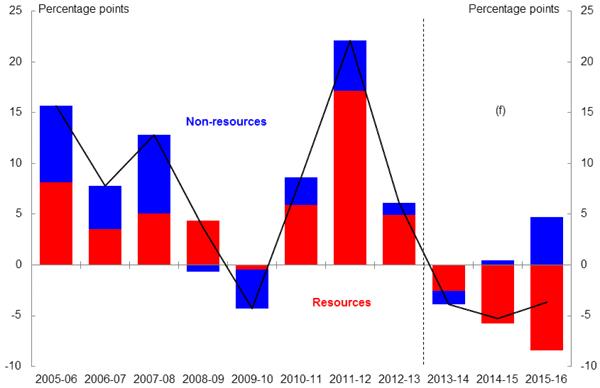
Note: Forecasts are from the 2014-15 Budget.
Taken together, these developments translate into a 2014-15 Budget forecast of slightly below-trend economic growth of 2½ per cent in 2014-15 and 3 per cent in 2015-16, and an unemployment rate expected to drift up to around 6¼ per cent by the middle of next year. These forecasts are close to, or in some cases slightly more conservative than, the average of other forecasters.
To my mind, however, the crucial point is that these outcomes, if they are realised, will be remarkably benign, given the size of the economic adjustment we are living through. The downswing in resources investment will likely continue beyond the forecast horizon of the Budget, and so the appropriate verdict at present seems to me to be “so far, so good”.
Not a seamless transition, but hardly dog days. Nevertheless, there are still challenges ahead.
The needed medium-term adjustment in the economy will require stronger demand for the goods and services produced by the non-resource sectors of the economy, including non-resource export sectors. Therefore, part of this adjustment is likely to require a further significant depreciation of the currency. Such depreciation may be being delayed at present both because of a portfolio shift into Australian assets and because of the unconventional monetary policies being undertaken in much of the advanced world, where policy interest rates are up against the zero lower bound and expected to remain so for some time yet. When it comes, however, it will be important that nominal depreciation translates into real depreciation – which will be facilitated by continued moderate wage outcomes and stronger productivity growth, a point also made by Professor Garnaut.
Second, it seems likely that income growth will be sluggish for some time. Assuming an average productivity performance, income for the average citizen is likely to grow more slowly over the next decade or so than it has in each of the previous five decades, predominantly as a consequence of the expected further decline in the terms of trade (Chart 9).
The only way to avoid this outcome is through a sustained program of productivity-enhancing reform – a point that has been emphasised for some time by the Government, the Treasury, and also by Professor Garnaut.
Thank you.
Chart 9 – Contributions to average growth in gross national income per capita
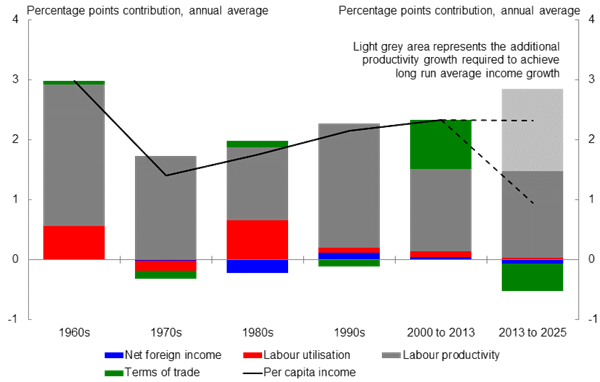
Note: Forecasts for 2013 to 2025 are consistent with the forecasts and projections in the 2014-15 Budget. The lower dotted line shows the outcome assuming labour productivity growth is at its long-term average.
References
Connolly, E. & Orsmond, D. 2011, ‘The mining industry: from bust to boom’, Reserve Bank of Australia Research Discussion Paper 2011-08.
Edwards, J. 2014, ‘Beyond the Boom’, a Lowy Institute Paper, Penguin Books.
Garnaut, R. 2013, ‘Dog Days: Australia after the Boom’, Redback, Collingwood.
Gruen, D. 2006, ‘A tale of two terms-of-trade booms’, Address to the Australian Industry Group, Economy 2006 Forum, Melbourne, 1 March 2006.
Gruen, D. 2011, ‘The macroeconomic and structural implications
of a once-in-a-lifetime boom in the terms of trade’, Address to the Australian Business Economists, 24 November 2011.
Parkinson, M. 2014, ‘The 2014-15 Budget and sustaining broad based growth in living standards’, Speech to the Australian Business Economists, Sydney, 20 May 2014.
Sheehan, P. & Gregory, RG. 2013, ‘The resources boom and economic policy in the long run’, The Australian Economic Review, Vol. 46, No. 2, pp. 121-139.
1 Speech by the first author to the Australian Conference of Economists, Hobart, 3 July 2014. We are grateful to Simon Duggan, Nicholas Gruen, Barry Sterland and Ross Garnaut for helpful comments on an earlier draft.
2 A similar sentiment has been expressed by Bob Gregory and Peter Sheehan (2013), who emphasise the importance of a sustained coordinated macroeconomic policy response to the impending contractionary shock. By contrast, John Edwards (2014) is much more optimistic.
3 With somewhat of a delay, LNG joined the boom. Over the next few years, it will account for the majority of resources investment.
4 With the macroeconomic frameworks of the time, the much smaller 1970s boom was nevertheless very disruptive for the Australian economy (see Gruen, 2006).
5 Over the first three quarters of 2013-14, resources investment is estimated to have fallen by about ½ a percentage point of GDP from its 2012-13 share.
6 In support of his argument that the current resources boom has had less impact on the economy than is commonly thought, Edwards (2014) points out that the 3 per cent average annual real GDP growth over the decade to the end of 2012 was markedly below the 3.8 per cent average over the previous decade. It should be noted, however, that the 1992-2002 decade saw above-trend growth as the economy recovered from the deep early 1990s recession, with unemployment falling from above 10½ per cent to below 6 per cent over the course of that decade. To my mind, it is a mark of the success of macroeconomic policy over the subsequent 2002-2012 decade that overall growth in the economy was close to trend, notwithstanding the sizeable boost to both incomes and aggregate demand from the big rises in the terms of trade and resources investment highlighted in Charts 1 and 2.
7 Edwards (2014) makes similar points with regard to both national consumption and national investment. On a separate point, it should be noted that much of the rise in private business investment was undertaken by predominantly foreign-owned companies – with foreign ownership in the resources sector estimated at around 80 per cent (Connolly and Orsmond, 2011).
8 The effect on domestic output of this expected sharp fall in investment will be smaller than these numbers suggest because resources investment has an import content of something like 50 per cent. On a separate point, the near quadrupling of the resources capital stock will require a much higher level of investment to replace depreciation. Based on current investment forecasts and using the most recent ABS estimate of the depreciation rate on capital in the resources sector (7½ per cent per annum), investment of nearly $50 billion (2¾ per cent of GDP) will be required in 2015-16 simply to cover depreciation.